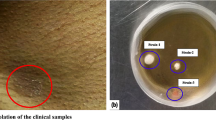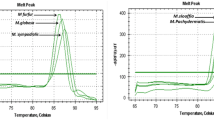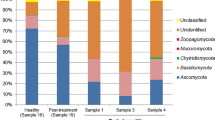Abstract
Pityriasis versicolor is a superficial infection of the stratum corneum caused by Malassezia yeasts. The cutaneous Malassezia globosa and Malassezia restricta in Sudanese patients with pityriasis versicolor were elucidated using a molecular-based, culture-independent method and compared with that in healthy individuals. Scale samples were collected by applying an Opsite™ transparent dressing to lesional and non-lesional sites on 29 Sudanese patients with pityriasis versicolor and 54 healthy individuals. Malassezia DNA was extracted directly from the samples. The overall level of colonization by Malassezia globosa and Malassezia restricta was analyzed by real-time PCR using a TaqMan probe. The overall level of colonization by Malassezia at the lesional sites was higher than that at the non-lesional sites for all body sites, including the face, neck, cheeks, and trunk (2.7- to 6.0-fold increase). Both M. globosa and M. restricta were detected in patients and healthy individuals. However, M. globosa predominated at lesional sites, whereas the level of colonization by both species was similar in healthy individuals.


Similar content being viewed by others
References
Ashbee HR. Update on the genus Malassezia. Med Mycol. 2007;45:287–303.
Gao Z, Perez–Perez GI, Chen Y, Blaser MJ. Quantitation of major human cutaneous bacterial and fungal populations. J Clin Microbiol. 2010;48:3575–81.
Gupta AK, Batra R, Bluhm R, Boekhout T, Dawson TL Jr. Skin diseases associated with Malassezia species. J Am Acad Dermatol. 2004;51:785–98.
Morishita N, Sei Y. Microreview of Pityriasis versicolor and Malassezia species. Mycopathologia. 2006;162:373–6.
Gupta AK, Batra R, Bluhm R, Faergemann J. Pityriasis versicolor. Dermatol Clin. 2003;21:413–29.
Sugita T, Suto H, Unno T, Tsuboi R, Ogawa H, Shinoda T, Nishikawa A. Molecular analysis of Malassezia microflora on the skin of atopic dermatitis patients and healthy subjects. J Clin Microbiol. 2001;39:3486–90.
Morishita N, Sei Y, Sugita T. Molecular analysis of Malassezia microflora from patients with pityriasis versicolor. Mycopathologia. 2006;161:61–5.
Sugita T, Tajima M, Tsubuku H, Tsuboi R, Nishikawa A. Quantitative analysis of cutaneous Malassezia in atopic dermatitis patients using real-time PCR. Microbiol Immunol. 2006;50:549–52.
Takahata Y, Sugita T, Hiruma M, Muto M. Quantitative analysis of Malassezia in the scale of patients with psoriasis using a real-time polymerase chain reaction assay. Br J Dermatol. 2007;157:670–3.
Amaya M, Tajima M, Okubo Y, Sugita T, Nishikawa A, Tsuboi R. Molecular analysis of Malassezia microflora in the lesional skin of psoriasis patients. J Dermatol. 2007;34:619–24.
Tajima M, Sugita T, Nishikawa A, Tsuboi R. Molecular analysis of Malassezia microflora in seborrheic dermatitis patients: comparison with other diseases and healthy subjects. J Invest Dermatol. 2008;128:345–51.
Sugita T, Boekhout T, Velegraki A, Cuillot J, Hadina S, Cabanes FJ. Epidemiology of Malassezia-related skin diseases. In: Boekhout T, Gueho E, Mayser P, Velegraki A, editors. Malassezia and the skin, science and clinical practice. NY: Springer; 2010. p. 65–120.
Gueho-Kellermann E, Batra R, Boekhout T. In The Yeasts, A Taxonomic Study, Malassezia Baillon. 5th edition. In: Kurtzman CP, Fell J, Boekhout T,editors. ELSIVIER: Amsterdam; pp. 1807–1832.
Petry V, Tanhausen F, Weiss L, Milan T, Mezzari A, Weber MB. Identification of Malassezia yeast species isolated from patients with pityriasis versicolor. An Bras Dermatol. 2011;86:803–6.
Trabelsi S, Oueslati J, Fekih N, Kammoun MR, Khaled S. Identification of Malassezia species from Tunisian patients with pityriasis versicolor. Tunis Med. 2010;88:85–7.
Giusiano G, Sosa Mde L, Rojas F, Vanacore ST, Mangiaterra M. Prevalence of Malassezia species in pityriasis versicolor lesions in northeast Argentina. Rev Iberoam Micol. 2010;27:71–4.
Chaudhary R, Singh S, Banerjee T, Tilak R. Prevalence of different Malassezia species in pityriasis versicolor in central India. Indian J Dermatol Venereol Leprol. 2010;76:159–64.
Shokohi T, Afshar P, Barzgar A. Distribution of Malassezia species in patients with pityriasis versicolor in Northern Iran. Indian J Med Microbiol. 2009;27:321–4.
Karakaş M, Turaç-Biçer A, Ilkit M, Durdu M, Seydaoğlu G. Epidemiology of pityriasis versicolor in Adana. Turk J Dermatol. 2009;36:377–82.
Krisanty RI, Bramono K, Made Wisnu I. Identification of Malassezia species from pityriasis versicolor in Indonesia and its relationship with clinical characteristics. Mycoses. 2009;52:257–62.
Prohic A, Ozegovic L. Malassezia species isolated from lesional and non-lesional skin in patients with pityriasis versicolor. Mycoses. 2007;50:58–63.
Gaitanis G, Velegraki A, Alexopoulos EC, Chasapi V, Tsigonia A, Katsambas A. Distribution of Malassezia species in pityriasis versicolor and seborrhoeic dermatitis in Greece. Typing of the major pityriasis versicolor isolate M. globosa. Br J Dermatol. 2006;154:854–9.
Tarazooie B, Kordbacheh P, Zaini F, Zomorodian K, Saadat F, Zeraati H, Hallaji Z, Rezaie S. Study of the distribution of Malassezia species in patients with pityriasis versicolor and healthy individuals in Tehran. Iran BMC Dermatol. 2004;1(4):5.
Gupta AK, Kohli Y, Faergemann J, Summerbell RC. Epidemiology of Malassezia yeasts associated with pityriasis versicolor in Ontario. Can Med Mycol. 2001;39:199–206.
Crespo Erchiga V, Ojeda Martos A, Vera Casaño A, Crespo Erchiga A, Sanchez Fajardo F. Malassezia globosa as the causative agent of pityriasis versicolor. Br J Dermatol. 2000;143:799–803.
Acknowledgments
This study was supported in part by a Grant-in-Aid from the Japan Society for the Promotion of Science (JSPS), a research grant from the Asian and African Science Platform Program from JSPS, and the “High-Tech Research Center Project” from the Ministry of Education, Culture, Sports, Science, and Technology, Japan (TS).
Conflict of interest
There were no conflicts of interest.
Author information
Authors and Affiliations
Corresponding author
Rights and permissions
About this article
Cite this article
Saad, M., Sugita, T., Saeed, H. et al. Molecular Epidemiology of Malassezia globosa and Malassezia restricta in Sudanese Patients with Pityriasis Versicolor. Mycopathologia 175, 69–74 (2013). https://doi.org/10.1007/s11046-012-9587-y
Received:
Accepted:
Published:
Issue Date:
DOI: https://doi.org/10.1007/s11046-012-9587-y




